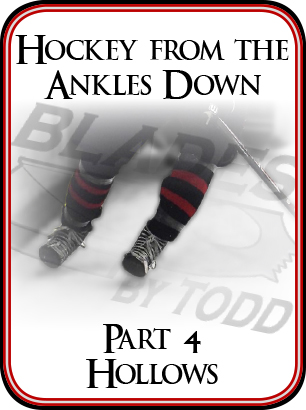Over the years I have heard a lot of funny statements; “Just sharpen my skates a little bit”, “I want a defenseman’s cut”, “because I’m a bigger player, I need a deeper hollow”, “just sharpen them the regular way”, “I only get my skates done once a year”, “can you put an edge on my Rollerblades?”. What is amazing is how little is known about the subject of hollows, even at the higher levels of hockey. That means there is very little instruction being given at any level for what might be one of the most important aspects of a skater’s skills.
“How sharp are your skates?” This is a good question requiring an answer more then yes or no. Different hollows control the sharpness of your skates, although all should have a good edge, some hollows have more bite in the ice. The first thing to understand is that the deeper the hollow the more the edges sink into the ice and the less glide the skater will have between each stroke.
The extreme example is the long track speed skater whose blades have no hollow. They have a good edge, but the bottom of their blade is totally flat which causes no drag. So we now have high-level hockey players on very flat hollows in order to maintain speed which takes less effort.
For the accomplished hockey player, they must find that balance between speed and grip. The grip comes into play in the corners and in front of the net. Players push on each other and the one who can’t hold his edge is the one that moves. Thus we must analyze the player’s game style, position, and comfort level. For game style, consider their size and whether they are looking for speed or for power.
A player’s position usually has an affect on their game style, and for comfort one should find the least amount of hollow that allows them to maintain their game style and position. In other words, there is a difference between the forward flying through the slot and the defenseman who is expected to stop him.
Let’s say the defenseman is a big guy who is not a particularly fast skater but is expected to keep the slot clear. Less hollow is not going to make him a better skater, but a deeper hollow will give this player more grip in front of the net. On the other hand, if a coach expects a fast defenseman to join in the attack, I would recommend less hollow to help with speed, both in the attack and getting back when caught in too deep. Most forwards are looking for speed, so less hollow is the answer.
A player with less weight might be better off with a little deeper hollow. Less weight will not sink the edges as deep in the ice, but sharper edges may help with the physical game in the corners. Another benefit players have found from less hollow is fewer injuries. Because the edges are not so deep into the ice, their blades don’t get stuck in the ruts as easily, thus there are fewer groin and knee injuries.
There are still players who don’t like to get their skates sharpened very often. In my opinion that is because they have not had a professional take care of their skates yet, and they don’t know what they are missing. The past statements still hold true in that they want their “dull” skates not to catch in the ruts, and also have the easy flow for speed, but for these skaters I would recommend a deeper hollow that is purposely dulled back to their comfort level. This is still an efficient edge, but I find it easier to keep a player’s skates sharp rather then finding a consistent dull edge that always feels the same, game after game.

